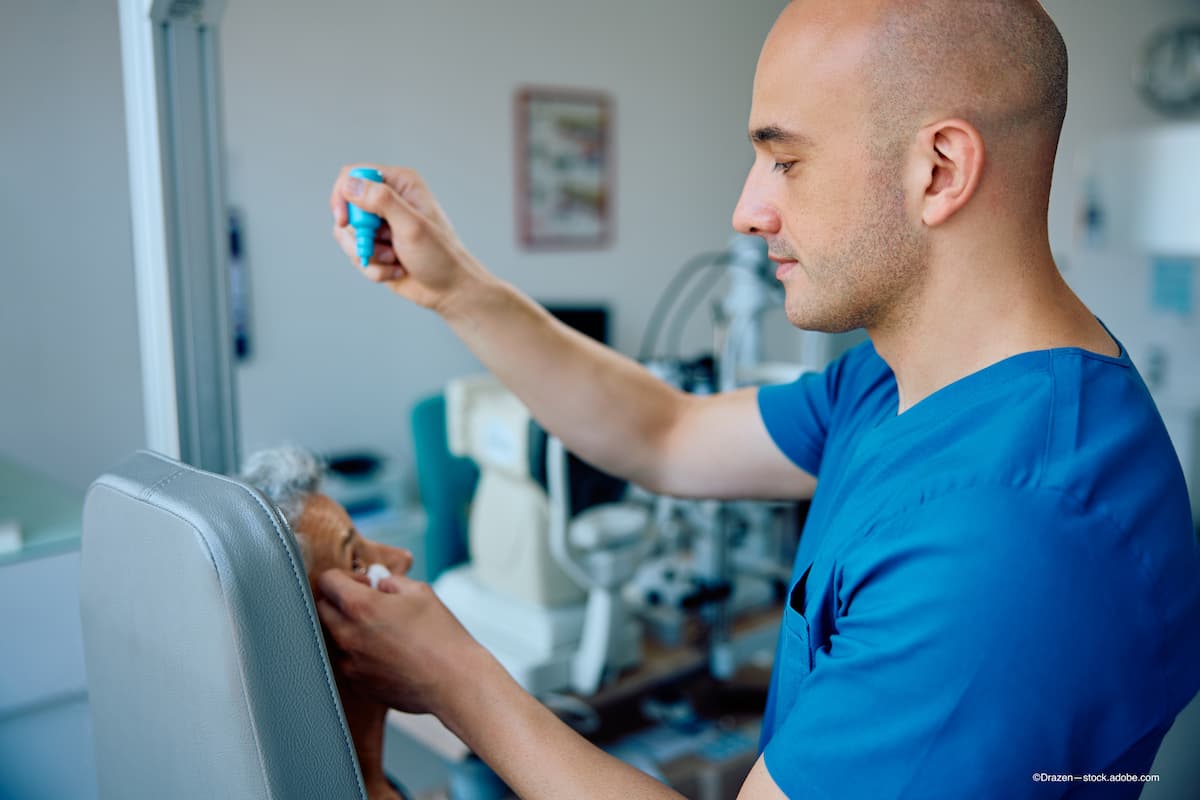Phentolamine 0.75% launches commercially in the US
Phentolamine ophthalmic solution 0.75% is a preservative-free, stable eye drop, which blocks the α1 receptor within the iris dilator muscle without affecting the ciliary muscle.
(Image credit: Adobe Stock / Drazen)

Viatris announced the US commercial launch of phentolamine ophthalmic solution (Ryzumvi) 0.75% for the treatment of pharmacologically-induced mydriasis produced by adrenergic agonists (eg, phenylephrine) or parasympatholytic (eg, tropicamide) agents in the United States.
According to a news release, phentolamine ophthalmic solution 0.75% is now the only US commercially available FDA-approved eye drop to reverse dilation.1
Phentolamine ophthalmic solution 0.75% is a preservative-free, stable eye drop, which blocks the α1 receptor within the iris dilator muscle without affecting the ciliary muscle. The result is intended to reverse pharmacologically-induced mydriasis, presbyopia and night vision disturbances.
In the US an estimated 100 million eye dilations take place each year for routine check-ups, disease monitoring or surgical procedures of the retina.2 Side effects of pharmacologically-induced mydriasis include sensitivity to light (photophobia) and blurred vision, lasting up to 24 hours, which may make it difficult to read, work and drive.3
According to the American Academy of Ophthalmology and the American Optometric Association, clinical practice guidelines recommend dilation as a standard of care.1 Dilation allows eye care providers to identify both common and serious eye health issues, including signs of systemic disease. The average time of dilation lasts 3 to 8 hours, but can last up to 24 hours in some people. Prolonged dilation may lead to patients refusing dilation.1
According to the news release, comprehensive dilated eye exams play a vital role in detecting potential vision-impairing ophthalmic conditions such as cataracts and potentially blinding diseases like glaucoma, diabetic retinopathy, and age-related macular degeneration. Additionally, comprehensive dilated eye exams can uncover evidence of systemic diseases like diabetes, rheumatoid arthritis, and hypertension.1
In September 2023, the FDA approved phentolamine ophthalmic solution 0.75% for the reversal of pharmacologically-induced mydriasis (RM) produced by adrenergic agonist or parasympatholytic agents, or a combination thereof, which has been formulated by Ocuphire Pharma and Viatris.2 Formerly known as Nyxol, the solution is a preservative-free, stable eye drop, which blocks the α1 receptor within the iris dilator muscle without affecting the ciliary muscle. The result is intended to reverse pharmacologically-induced mydriasis, presbyopia and night vision disturbances.
According to the news release, the solution was evaluated across 2 randomly assigned, vehicle-controlled, double-masked MIRA-2 and MIRA-3 clinical trials in which patients (N=553) aged 12 to 80 years who had mydriasis induced by instillation of phenylephrine, tropicamide, or Paremyd (hydroxyamphetamine hydrobromide and tropicamide) were administered 2 drops (in the study eye) or 1 drop (in the fellow eye) of either RYZUMVI or placebo one hour after instillation of the mydriatic agent.
The company noted the onset of action of the solution generally occurs in 30 minutes. In the MIRA-2 and MIRA-3 clinical trials, at 90 minutes after administration, 49% and 58% of patients administered 2 drops of the solution returned to ≤ 0.2 mm of baseline pupil diameter compared to 7% and 6% of patients administered placebo, respectively. In the MIRA-2 trials' placebo group, 34% of patients were still dilated (had not returned to ≤ 0.2 mm of baseline pupil diameter) at 24 hours. In the MIRA-3 trials' placebo group, 28% of patients were still dilated at 24 hours.1
According to the news release, the solution is not recommended to be used in patients with active ocular inflammation (e., iritis). To avoid the potential for eye injury or contamination, care should be taken to avoid touching the vial tip to the eye or to any other surface. Contact lens wearers should be advised to remove their lenses prior to the installation of RYZUMVI and wait 10 minutes after dosing before reinserting their contact lenses.1
Phentolamine ophthalmic solution 0.75% (Ryzumvi) safety information:
Uveitis: Phentolamine ophthalmic solution 0.75% (Ryzumvi) is not recommended to be used in patients with active ocular inflammation (e.g., iritis).
Potential for eye injury or contamination: Avoid touching the vial tip to the eye — or any other surface — to avoid potential for eye injury or contamination.
Use with contact lenses: Advise contact lens wearers to remove their lenses prior to the instillation of phentolamine ophthalmic solution 0.75% and wait 10 minutes after dosing before reinserting their contact lenses.4
Instillation site discomfort (16%), conjunctival hyperemia (12%), and dysgeusia (6%) have been the most commonly reported adverse reactions
References
1. Inc V. Viatris Announces the Launch of RYZUMVlTM (Phentolamine Ophthalmic Solution) 0.75% in the United States. www.prnewswire.com. Accessed April 1, 2024. https://www.prnewswire.com/news-releases/viatris-announces-the-launch-of-ryzumvl-phentolamine-ophthalmic-solution-0-75-in-the-united-states-302104117.html
2. Wilson FA, Stimpson JP, Wang Y. Inconsistencies exist in national estimates of eye care services utilization in the United States. J Ophthalmol. 2015;2015:435606. doi: 10.1155/2015/435606. Epub 2015 Aug 9. PMID: 26346484; PMCID: PMC4546761
3. PARAMYD (hydroxyamphetamine hydrobromide/ tropicamide ophthalmic solution) 1%/0.25% US prescribing information. Somerset, NJ.: Akorn, Inc.; 2001.
4. US FDA approves RYZUMVI (Phentolamine Ophthalmic Solution) for the treatment of pharmacologically-induced mydriasis. Ophthalmology Times. Published September 27, 2023. Accessed April 1, 2024. https://europe.ophthalmologytimes.com/view/us-fda-approves-ryzumvi-phentolamine-ophthalmic-solution-for-the-treatment-of-pharmacologically-induced-mydriasis
Newsletter
Want more insights like this? Subscribe to Optometry Times and get clinical pearls and practice tips delivered straight to your inbox.